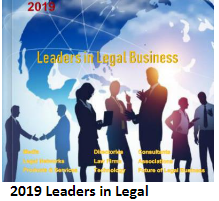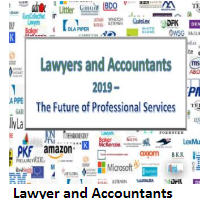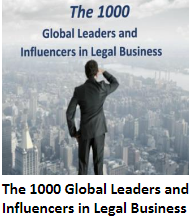Jordan Furlong Principal, Law21
Jordan Furlong of Ottawa, Canada, is a consultant, author, and legal market analyst who forecasts the impact of changing market conditions on lawyers and law firms. He has given dozens of presentations to audiences in the US, Canada, Europe, and Australia over the past several years, including to law firms, state bars, courts, and many legal associations. Formerly an award-winning editor of three major Canadian legal periodicals, Jordan is also a Fellow of the College of Law Practice Management and a member of the Advisory Board of the American Bar Association's Center for Innovation. He is the author, most recently, of Law is a Buyer's Market: Building a Client-First Law Firm, and he writes regularly about the changing legal market at his website, law21.ca.
_________________________________________________________________
The practice of law is hundreds of years old. Today’s complex ecosystem of professionals that supports manages, and improves the practice of law is considerably younger.
Think back
30 years from the date of this book’s publication. If you were a lawyer in 1988,
your law practice support system likely included a secretary, an accountant, a
courier, and maybe someone to explain how the telex worked. Outside the office,
resources to help you run your practice effectively and profitably were few and
far between. The idea of professionalized law practice management support was
foreign to most lawyers.
The real story of modern law practice management is how quickly this kind of support system moved from unimaginable to unremarkable. Starting with solo and small-firm lawyers, then gradually making its way into the ranks of larger firms, professional assistance for running a law practice has become part of the mainstream — and has gone a long way toward transforming the legal profession in a very short period of time.
The Legal Ecosystem
Why
did this happen so fast? Primarily, because law practice is hard; it takes an
enormous amount of attention and effort just to serve clients well. Lawyers
needed and eventually welcomed all the help they could get in doing everything
else, like running their businesses. The value these services provided to
lawyers was immediate and self-evident, which accelerated their adoption.
Furthermore, these services naturally cross-pollinated: Technology helped with
networking, which aided marketing and abetted consulting, which intersected with
process improvement, and so forth.
This is why we refer to this as an
ecosystem: a diversified, interconnected array of professional business support
systems for legal services providers. To use the classic definition by James F.
Moore, a business ecosystem is “an economic community, supported by a
foundation of interacting organizations and individuals … [that] produces goods
and services of value to customers, who are themselves members of the ecosystem
… [along with] suppliers, lead producers, competitors, and other stakeholders.”
In this market, the customers are lawyers and law firms. So, who are the members of the “community” — the suppliers of value in the modern legal ecosystem? As the legal market generally and the legal profession in particular undergo rapid and extensive change, what does the future hold for all these suppliers? Here are my thoughts on seven select members of the present legal support ecosystem, and how each will evolve in the years to come.
Outside Consultants
Third-party
consultants in the legal market are a relatively recent development, and for
the last couple of decades of the 20th century, strategic consulting was the
dominant offering. Law firms, at that time managed almost exclusively by
lawyers, needed expert guidance on growth strategies, compensation systems, and
business development efforts. Today, however, law firm management and even
leadership have become much more professionalized, and a great deal of
traditional strategic and tactical consulting capacity has been brought
in-house. There is still a role for strategic consulting; law firms require
big-picture perspectives and authoritative analyses of their businesses
compared with market leaders. As many law firms enter a period of generational
transition amid market upheaval, however, strategic consulting’s focus has
shifted from merely growing firms’ annual profits to overseeing fundamental
reconsiderations of firms’ purpose, markets, clients, and services.
At the same time, a wealth of other consulting opportunities is opening up in the law firm world. As law firms become more sophisticated, multi-dimensional businesses, they will require assistance from increasingly specialized advisers. In addition to the subjects explored elsewhere in this chapter (sales and marketing, professional development, technology, and process improvement), outside consultants will be called upon to help law firms improve the diversity of their personnel, price their services both predictably and profitably, develop new product and service lines, and train their future leaders. Even as law firms continue to insource such expertise with full-time staff members, there should still be plenty of opportunities for outside consultants to help law firms achieve their strategic and tactical goals.
Law Firm Networks
Founded
in the pre-globalization era, law firm networks offered their members
cross-border connections, perspectives, and
business development opportunities otherwise available only to a small handful
of international law firms. Today, however, as global mergers and expansions
have become more common, these networks must reexamine their purpose and grow
their value beyond the merely cross-jurisdictional. This is especially the case
given the increasing number of such networks and the rise of unexpected
competition from sources such as Dentons LLP, which is aggressively expanding
its own international referral network.
Success is likely to flow to those networks that can build a truly integrated and collaborative environment for their members. It will not be enough simply to help facilitate referrals between member law firms; networks will have to build solid, long-term relationships among their law firms in which numerous types of collaboration can thrive. These will include industry group conferences, management summits, “best practices” databases, associate exchanges and secondments, and so forth. The goal should be to tighten the bonds that hold the firms together, to build a “most favoured nation” alliance of similarly situated but non-competing firms. The networks’ administrators will do what they can, but ultimately, the fate of these networks rides on the willingness and ability of member firms to take concrete steps to foster bonds of collegial inter-dependence among themselves. The degree of active commitment by their firms to the whole project might determine the fate of many law firm networks.
Professional Developers
Over the past decade or so, in response to a more competitive market environment, law firms have begun to pay more attention to many internal business and human resources matters. But perhaps no area has experienced as much growth in this regard as legal professional development. Whereas many firms were once content to let lawyers thrash away on straightforward tasks in order to “learn the ropes,” most firms have now instituted formal, structured programs for upgrading the skills of their lawyers in several dimensions. Almost every midsize or larger firm has a PD director and staff, and many have established their own bespoke training systems, practice update services, and even internal “academies” or “universities. ”
Tomorrow’s law firm professional development will bear little resemblance to yesterday’s “CLE” culture of one-to-many, in-person, knowledge-update gatherings of unpaid lecturers and expert panels of talking heads. Both private sector and in-house providers of professional development will shift their focus away from “what’s new in the law” toward skill-building sessions, client-relationship role-playing, hands-on legal technology engineering, and other practical applications of legal expertise. Major firms will tailor their PD plans for each individual lawyer, customized to his or her needs and interests. Lifelong, multi-dimensional learning will be seen as a natural part of basic lawyer competence, and likely will be regulated, administered, and enforced as such. The professionalization of law firm PD, already well underway, will only accelerate and add new dimensions in the coming years.
Marketers and Salespeople
It
wasn’t easy to be a legal marketer when lawyer advertising was a de facto ethical violation or when the typical lawyer’s
view on the subject was that “the good work I do is all the marketing I need.”
But times have changed, and by any measure, legal marketing has matured and
flourished within the legal profession incredibly rapidly. Every major law firm
now employs marketing personnel, including C-level marketing directors who play
a growing role in strategy and business development. As data and analytics
flourish in the legal industry and new opportunities for competitive
intelligence-gathering open up, marketing will continue to expand its influence
in law firm decision-making.
But the real growth story of the next several years will be in sales. Law firms have long resisted the use of the “s” word, preferring the euphemistic term “business development” to preserve lawyerly dignity. It will become increasingly clear to law firms, however, that most lawyers are mediocre salespeople at best, and that asking legal subject experts to also be accomplished rainmakers is a distracting and discouraging exercise for all but the most preternaturally gifted practitioners. Faced with far more discerning and demanding clients, as well as substantially more aggressive competitors, law firms will begin employing salespeople to develop and eventually manage the law firm sales process, relegating lawyers to their proper role of subject-matter authorities and skilled legal practitioners. Bonuses and even commissions for salespeople will become a reality in law firms, and regulators will reluctantly but inevitably change ethics codes as a result. It will happen sooner than you might think
Technologists
Any
tool or process that increases the quality, efficiency, or effectiveness of a
lawyer’s work is “technology.” The typewriter was technology, as were the
photocopier, the fax machine, and dial-up modems that accessed the “information
superhighway,” but each of these new tools faced higher hurdles to acceptance
in law firms than in other businesses. That resistance probably won’t disappear
entirely, so long as lawyers constitute the bulk of law firm workers, but it
has already decreased substantially and will continue to do so.
The next stage in technology’s infiltration of law firms is the role of technologists themselves. This broad term encompasses a range of technical and professional experts. Some will be programmers who design both internal systems for the creation and delivery of client services and external systems for standalone access by clients to the firm’s distilled and productized expertise. Others will be artificial intelligence engineers who advise firms about the potential for machine-learning and cognitive-reasoning systems to improve the quality of legal advice (say, predictive analytics for litigation groups) or create new offerings altogether. And others will be data-collecting bloodhounds who derive insights from the firm’s own vast storehouses of unstructured information and who team up with library and knowledge professionals to turn that data into value for the firm and its clients. “Every company is going to become a tech company in some capacity,” said Marcie Borgal Shunk, founder of the Tilt Institute. “That ultimately is going to be true of professional service firms and law firms as well.”
Process Analysts
The
last frontier in the professionalization of law firms is the reinvention of
workflow and operations. Traditionally, it didn’t really matter how a law firm
went about its work, so long as a top-quality product or service emerged at the
end and so long as the lawyers who rendered the service were compensated for
their hours of effort. In a cost-plus business model, efficiency was not only
not especially valuable, it arguably was also counterproductive to the goal of
higher revenue. But as clients began pushing their law firms harder for
fixed-fee arrangements and more competitive prices, inefficiency gradually came
to be seen as a liability to law firm profitability. Inevitably, law firms
slowly began turning to process analysts to help them re-engineer their
approach to service delivery.
In some respects, “systems” are the new technology. Process improvement initiatives are gaining traction in select law firms — from legal project management, which places structured frameworks of timelines, budgets, and reporting responsibilities around legal work, to legal process mapping, which involves the step-by-step breakdown and efficiency analysis of the stages involved in frequently undertaken tasks. It’s not enough for law firms to offer the best “product” anymore; the race now is to provide the best productivity and the best operational platform for lawyers, and thereby generate the most effective outcomes and solutions for clients. Process analysts will often make the difference between the winners and losers of this race.
NewLw
A term first coined by Dr. George Beaton of Australia, “NewLaw” can be broadly defined as any model, process, or tool that represents a significantly different approach to the creation or provision of legal services than what the legal profession traditionally has employed. NewLaw providers are a unique hybrid of buyer and seller, providing services and support both to law firms and to clients (as well as to each other). Over the past five years, a virtual Cambrian Explosion of NewLaw providers has jolted the global legal marketplace. A powerful NewLaw player is as likely to disrupt and unseat a traditional law firm as it is to overturn a strategic consultancy, a marketing platform, or a technology offering. Examples of NewLaw entities include:
•
New-model law firms such as Riverview Law,
Valorem Law, and Keystone Law
•
Project-based legal talent providers such as Axiom, Caravel, and Lawyers On Demand
•
Managed legal support services like Novus Law,
Radiant Law, and Elevate
• A host of technology-powered law business such as Lex Machina, Premonition, KMStandards, MetaJure, Neota Logic, Avvo, Kira Systems, Relativity, Koncision, Clio, Ravel Law, ROSS Intelligence, LexPredict, and Modria.
NewLaw
firms refuse to fit easily into either the “supplier” or the “provider”
categories of the legal support ecosystem. More such entities will emerge in
the coming years, further blurring the lines between direct suppliers of legal
services to clients and complementary providers of support and guidance to
those suppliers. This ecosystem is going to become more complex and diverse,
not less.
So, when you read through the comprehensive and incisive essays to follow, cataloguing and analyzing today’s legal support ecosystem and the challenges it faces in future, keep two things in mind: just how quickly this entire professional support structure emerged, developed, and established itself over the past 30 years; and just how quickly and completely everything we know and recognize.

 Software
Software Law
Law Legal
Legal






